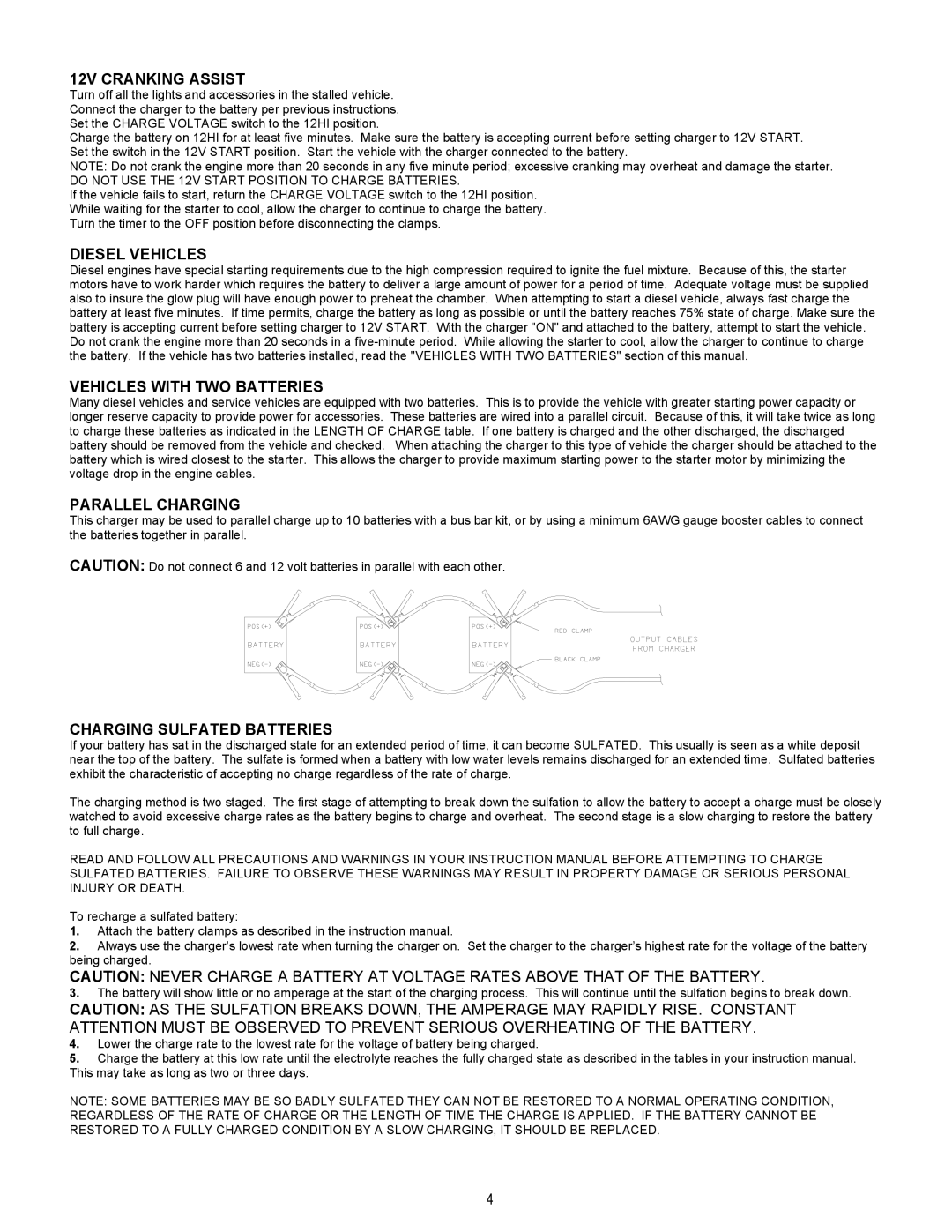
12V CRANKING ASSIST
Turn off all the lights and accessories in the stalled vehicle. Connect the charger to the battery per previous instructions. Set the CHARGE VOLTAGE switch to the 12HI position.
Charge the battery on 12HI for at least five minutes. Make sure the battery is accepting current before setting charger to 12V START. Set the switch in the 12V START position. Start the vehicle with the charger connected to the battery.
NOTE: Do not crank the engine more than 20 seconds in any five minute period; excessive cranking may overheat and damage the starter.
DO NOT USE THE 12V START POSITION TO CHARGE BATTERIES.
If the vehicle fails to start, return the CHARGE VOLTAGE switch to the 12HI position. While waiting for the starter to cool, allow the charger to continue to charge the battery. Turn the timer to the OFF position before disconnecting the clamps.
DIESEL VEHICLES
Diesel engines have special starting requirements due to the high compression required to ignite the fuel mixture. Because of this, the starter motors have to work harder which requires the battery to deliver a large amount of power for a period of time. Adequate voltage must be supplied also to insure the glow plug will have enough power to preheat the chamber. When attempting to start a diesel vehicle, always fast charge the battery at least five minutes. If time permits, charge the battery as long as possible or until the battery reaches 75% state of charge. Make sure the battery is accepting current before setting charger to 12V START. With the charger "ON" and attached to the battery, attempt to start the vehicle. Do not crank the engine more than 20 seconds in a
VEHICLES WITH TWO BATTERIES
Many diesel vehicles and service vehicles are equipped with two batteries. This is to provide the vehicle with greater starting power capacity or longer reserve capacity to provide power for accessories. These batteries are wired into a parallel circuit. Because of this, it will take twice as long to charge these batteries as indicated in the LENGTH OF CHARGE table. If one battery is charged and the other discharged, the discharged battery should be removed from the vehicle and checked. When attaching the charger to this type of vehicle the charger should be attached to the battery which is wired closest to the starter. This allows the charger to provide maximum starting power to the starter motor by minimizing the voltage drop in the engine cables.
PARALLEL CHARGING
This charger may be used to parallel charge up to 10 batteries with a bus bar kit, or by using a minimum 6AWG gauge booster cables to connect the batteries together in parallel.
CAUTION: Do not connect 6 and 12 volt batteries in parallel with each other.
CHARGING SULFATED BATTERIES
If your battery has sat in the discharged state for an extended period of time, it can become SULFATED. This usually is seen as a white deposit near the top of the battery. The sulfate is formed when a battery with low water levels remains discharged for an extended time. Sulfated batteries exhibit the characteristic of accepting no charge regardless of the rate of charge.
The charging method is two staged. The first stage of attempting to break down the sulfation to allow the battery to accept a charge must be closely watched to avoid excessive charge rates as the battery begins to charge and overheat. The second stage is a slow charging to restore the battery to full charge.
READ AND FOLLOW ALL PRECAUTIONS AND WARNINGS IN YOUR INSTRUCTION MANUAL BEFORE ATTEMPTING TO CHARGE SULFATED BATTERIES. FAILURE TO OBSERVE THESE WARNINGS MAY RESULT IN PROPERTY DAMAGE OR SERIOUS PERSONAL INJURY OR DEATH.
To recharge a sulfated battery:
1.Attach the battery clamps as described in the instruction manual.
2.Always use the charger’s lowest rate when turning the charger on. Set the charger to the charger’s highest rate for the voltage of the battery being charged.
CAUTION: NEVER CHARGE A BATTERY AT VOLTAGE RATES ABOVE THAT OF THE BATTERY.
3.The battery will show little or no amperage at the start of the charging process. This will continue until the sulfation begins to break down.
CAUTION: AS THE SULFATION BREAKS DOWN, THE AMPERAGE MAY RAPIDLY RISE. CONSTANT ATTENTION MUST BE OBSERVED TO PREVENT SERIOUS OVERHEATING OF THE BATTERY.
4.Lower the charge rate to the lowest rate for the voltage of battery being charged.
5.Charge the battery at this low rate until the electrolyte reaches the fully charged state as described in the tables in your instruction manual. This may take as long as two or three days.
NOTE: SOME BATTERIES MAY BE SO BADLY SULFATED THEY CAN NOT BE RESTORED TO A NORMAL OPERATING CONDITION, REGARDLESS OF THE RATE OF CHARGE OR THE LENGTH OF TIME THE CHARGE IS APPLIED. IF THE BATTERY CANNOT BE RESTORED TO A FULLY CHARGED CONDITION BY A SLOW CHARGING, IT SHOULD BE REPLACED.
4
